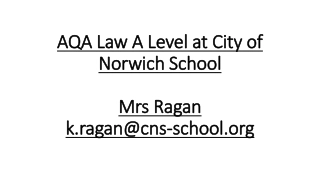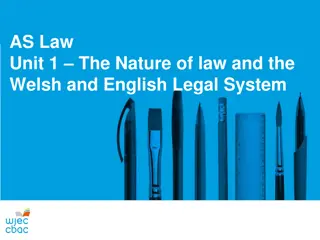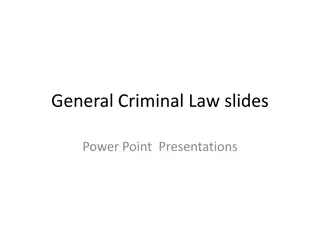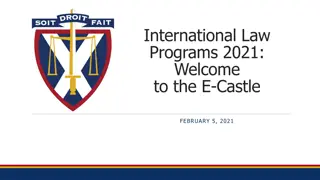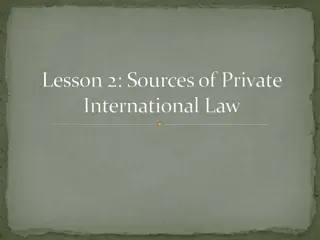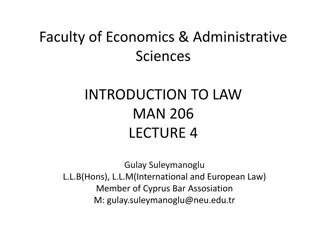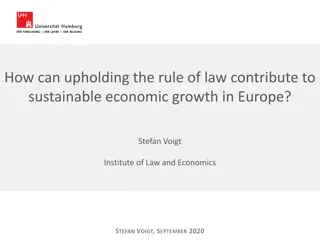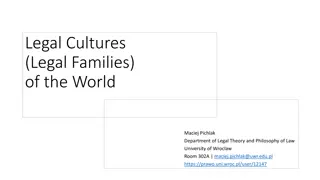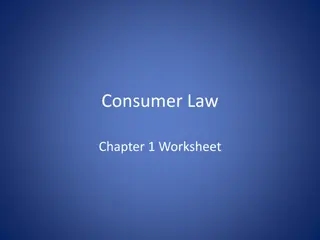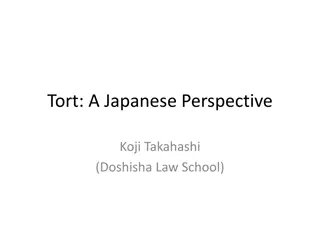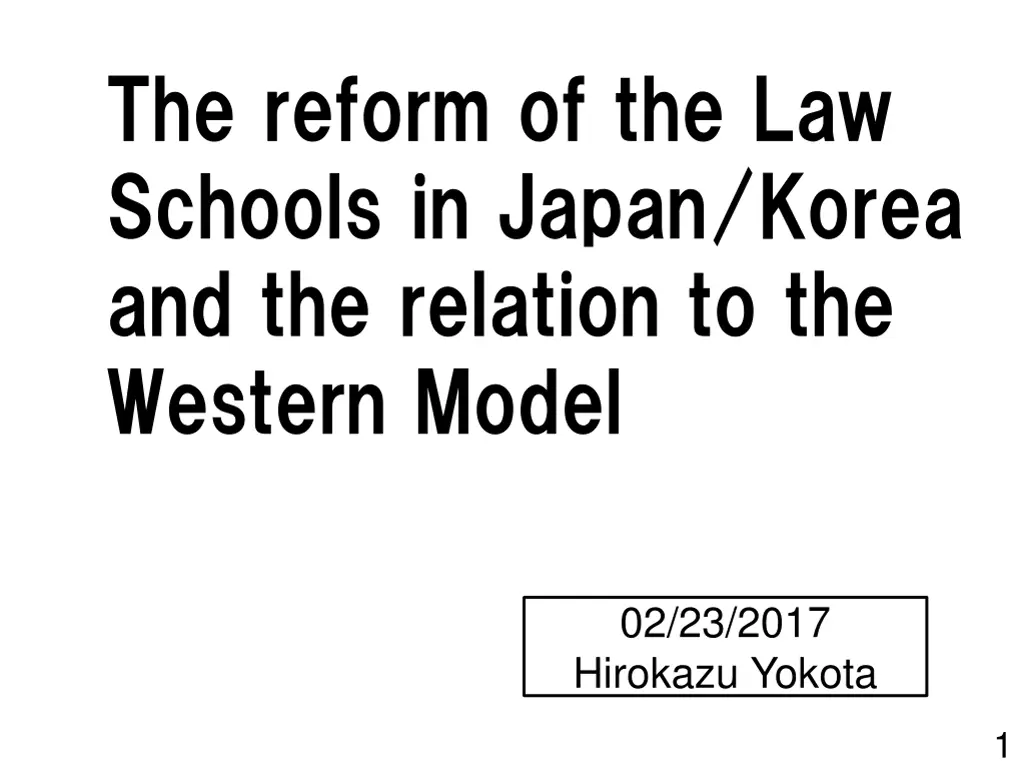
Law School Reform in Japan and Korea
Explore the reform of law schools in Japan and Korea, comparing their systems to the Western model. Discover the concept of law schools, admission criteria, student-faculty ratios, and bar exam regulations. Dive into the differences between Japan and Korea's approaches to legal education.
Download Presentation

Please find below an Image/Link to download the presentation.
The content on the website is provided AS IS for your information and personal use only. It may not be sold, licensed, or shared on other websites without obtaining consent from the author. If you encounter any issues during the download, it is possible that the publisher has removed the file from their server.
You are allowed to download the files provided on this website for personal or commercial use, subject to the condition that they are used lawfully. All files are the property of their respective owners.
The content on the website is provided AS IS for your information and personal use only. It may not be sold, licensed, or shared on other websites without obtaining consent from the author.
E N D
Presentation Transcript
The reform of the Law Schools in Japan/Korea and the relation to the Western Model 02/23/2017 Hirokazu Yokota 1
Introduction How do you think of Japan s Law School system? (Survey to Japanese people (74% of them from Law School) Working very well Working fairly well Not working well Not Working at all (N = 78) 2
Concept of Law School A solution to scarcity of lawyers (Competitive bar exam pass rate about 3%) A way of diversifying lawyers Provide better legal service Innovative teaching method (Socratic method, small class size) A bridge between theoretical and practical education But difference exists 3
Comparison Japan and Korea Law school Korea (2009-) Japan (2004-) Number Requirement 25 *restricted by government 74 (in 2005) 42 (in 2016) *no restriction Student-faculty ratio: less than 15 At least 20% of faculty: qualified lawyers (more than 5 years of experience) At lease one third of students: from non-law majors GPA, aptitude exam score, language ability, social or volunteer activities 3 years Student-faculty ratio: less than 15 At least roughly 20% of faculty: practitioners (more than 5 years of experience) At least 30% of students: from non-law majors (not required) GPA, aptitude exam score, language ability 3 years 2 years (those completed undergrad law degree) No restriction Admission Number of years Relation with law colleges Enrollment Restriction on taking bar exams Number of students passing bar exam Pass rate* Traditional bar exam Legal Training Approved law schools must abolish undergraduate law college 2,000 (limit set by government) Can take bar exam 5 times within 5 years after graduation More than 1,500 5,784 in 2006 1,857 in 2016 Can take bar exam 5 times within 5 years after graduation (until 2014, 3 times) <Target> 3,000 in 2002 1,500 in 2015 <Reality> About 1,000 (before reform) 1,583 in 2016 <Target> 70-80% <Reality> about 50% Traditional Bar Exam abolished and Preliminary Exam introduced in 2011 One year (after passing bar exam) At least 75% (stipulated by law) Traditional Bar Exam supposed to be abolished originally in 2012, then in 2017 Two years (after passing bar exam) 4 *Korea: pass rate for each year, Japan: cumulative pass rate over a certain years
Korea mandate policy, messiness Number of schools and enrollment: strictly controlled by government high pass rate Traditional bar exam considered to be a symbol of fairness Law schools too expensive ($14,097 annually)) said to be beneficial only to rich students In 2015, government decided to delay abolishing the traditional bar exam until 2021 (public opinion: 85% wants to keep it) huge protest Lack of transparency - corruption regarding admission to law schools 5
Japan inducement policy, messiness Number of schools not controlled More schools than expected more enrollment lower pass rate Cap on number of students passing bar exam decided not by market, but by capacity of courts (in charge of training) Number of applicants and enrollment substantially decreased 32 out of 74 law schools stopped to accept new students Preliminary exam as a shortcut Cram (prep) school problem still remains Pass rate gap between 3-year and 2-year program students Stipend system to trainees abolished in 2011 (will be revived in 2017) 6
Japan going back to my survey What s the biggest problem in Law School system? (N = 78) Lack of attractiveness and understanding in the job of lawyer Existence of preliminary exam Concentration of law schools in urban area Abolishment of stipend system Decrease in subsidy in some schools Lack of consistency in policy 7
Vicious Cycle Inconsistent Policy mismatch between demand and supply Policy / Market Failure 8
Real voices - again, going back to my survey <Overhaul> <Financial assistance> Providing more financial support (e.g. scholarships) (2) Abolish law school system (5) Abolish preliminary exam (4) Revival of stipend system (2) Fair allocation of subsidy Going back to old bar exam system (2) Examine the necessity of law schools (2) <Revision of restriction> <Quantity control> Decrease number of law schools or students so that pass rate would be 70- 80% (8) Abolish requirement of bar exam (graduation from law schools) (6) Impose restriction on eligibility for preliminary exam (2) Improve quality of education in law schools by limiting the number (4) Abolish restriction on the number of taking bar exam <Quality improvement> <Others> Improve curriculum of law schools (4) Implementation based on consistent policy (3) Improve quality of faculty (2) Strengthen its role as a bridge between theoretical and practical education (3) Improve attractiveness of lawyers / law schools (3) More involvement of Supreme Court and Ministry of Justice in system-making Allocate distinguished faculty and subsidies more to local law schools 9
For discussion What lessons can we draw from these reforms? What are your solutions, if any, to this messiness ? 10
References . (2009). Changing History: Ideals and Realities of new Professional Law Schools in Korea. , 44(3), 623-648. Kim, J. (2008). Socrates v. Confucius: An Analysis of South Korea's Implementation of the American Law School Model. APLPJ, 10, 322. Nam, H. (2004). US-Style Law School (Law School) System in Korea: Mistake or Accomplishment. Fordham Int'l LJ, 28, 879.. Yeo Jun-suk (September 08, 2015), Debate grows over fate of Korea s traditional bar exam, The Korea Herald, Retrieved fromhttp://www.koreaherald.com/view.php?ud=20150908001142 Jung Min-ho (December 05, 2015), Bar exam extension triggers huge backlash, The Korea Times, Retrieved from http://www.koreatimes.co.kr/www/news/nation/2015/12/116_192458.html Matsui, S. (2012). Turbulence ahead: The future of law schools in Japan. Journal of Legal Education, 62(1), 3-31. Riles, A., & Uchida, T. (2009). Reforming knowledge? A socio-legal critique of the legal education reforms in Japan. Tough time for law schools (January 21, 2015), The Japan Times, Retrieved from http://www.japantimes.co.jp/opinion/2015/01/21/editorials/tough-times-law- schools/#.WKvCHeQizmI 11

